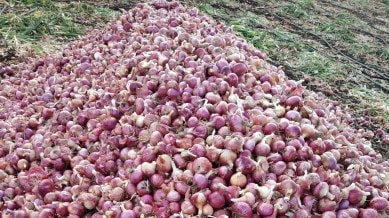Onion growers in Maharashtra are in a fix this year with climate vagaries, coupled with a shortage of local labourers and low prices, taking a toll on their yields. If it was the heat during March and April, it is the heavy downpour in some parts of the onion belt in May that has reduced the quality of their yield, catching many farmers unaware.
“Normally, the harvesting is done by local labour, but this year they flatly refused because of the extreme heat conditions,” says Sanap. His friends in Naigaon and the neighbouring village of Jaigaon faced the same problem.
Unlike crops such as wheat or gram, onions must be harvested manually, with zero mechanisation involved, making it a labour-intensive process. “With no solution in sight, we decided to travel to Dharampur town in Gujarat’s Valsad district to get labour,” says Sanap.
Sanap and 15 farmers from both the villages pooled their resources and hired a gang of 15 labourers who worked in rotation to complete the harvesting. “Every year, we face a labour problem, but this year, the heat and rising temperature were the problem,” he says.
The labour did not come cheap. Instead of the normal rate of Rs 300 per day, labourers from Gujarat were paid Rs 350 per day, along with lodging and boarding. “This year, the cost of harvesting came to about Rs 5,500 per acre as against the Rs 4,000 per acre we normally incur. But the situation was dire,” he says.
This year, the summer in Nashik, like in the rest of Maharashtra, was extremely harsh with temperatures crossing the 40-degree mark multiple times, leading to several heat-related illnesses.
Story continues below this ad
“Some of the local labourers who were employed in the task of harvesting in March fell ill at a time when the fields were getting ready for harvesting. The demand for labour went up drastically, but the supply was less than normal,” explains Santosh Digole, a farmer from Jaigaon village who was among the 15 who hired workers from Gujarat.
Rabi onion, which is normally sown in December-January, is harvested in March. Post-harvest, farmers store their produce in on-field storage structures called ‘kanda chawls’ and liquidate this crop till September-October when the Kharif onion hits the markets. Given the low moisture content, the rabi onion is amenable to storage and is crucial to feed the domestic as well as export markets. Farmers across the country have sown rabi onion over 12.53 lakh hectares – with Maharashtra alone reporting sowing over 7.43 lakh hectares. Estimates say around 10-15 per cent of the crop is yet to be harvested.
But the acute labour shortage has resulted in the harvesting window being extended, leaving many farmers worried.
Santosh Gorade, who grew rabi onion over 4 acres of land in Takli village in Nashik’s Niphad taluka, says he had to rely on tribal labour from Nandurbar and other border regions of Maharashtra and Gujarat to get his crop harvested. “The process is still on – after the harvest, the onion is dumped on the field from where it is transported to the chawl. However, due to the delay in harvesting, my crop suffered heat burns. Around 10 per cent of the onion crop had to be thrown away due to poor quality,” he says, adding, “It is a season of losses for us.”
Story continues below this ad
Gorade says this will be one of the rare seasons when the harvest window is so delayed. “Local labourers refuse to work in the heat, and we have to rely on labour from outside to get the work done,” he says.
Local labourers only work in shifts; instead of coming in at 9 am, they come an hour early and work till 11 am. Between 11 am and 4 pm, they take a break from work and shift to the shade. They continue after 4 pm and work till daylight remains. “This has slowed down the harvest,” says Gorade.
While the labour shortage issue is not new, Dipak Chavan, an agricultural commodity analyst, points out that local labourers now have work opportunities in their villages, making them reluctant to travel to Nashik.
“Traditionally, the local labour is supported by labour from Dhule and other areas in north Maharashtra. But, of late, a large number of mandis and ethanol production plants have come up there. Coupled with the heat, most labourers have failed to turn up for harvesting in Nashik,” he says. It was this labour shortage that caught the farmers from Pune and Nashik off guard.
Story continues below this ad
Torrential rains in the final phase, when the onion was being bagged, meant that many farmers lost a portion of their market-ready produce. Despite this, given the bumper crop most farmers have reported, the chances of a price escalation are unlikely.
